1993 CADILLAC SEVILLE headlights
[x] Cancel search: headlightsPage 91 of 407
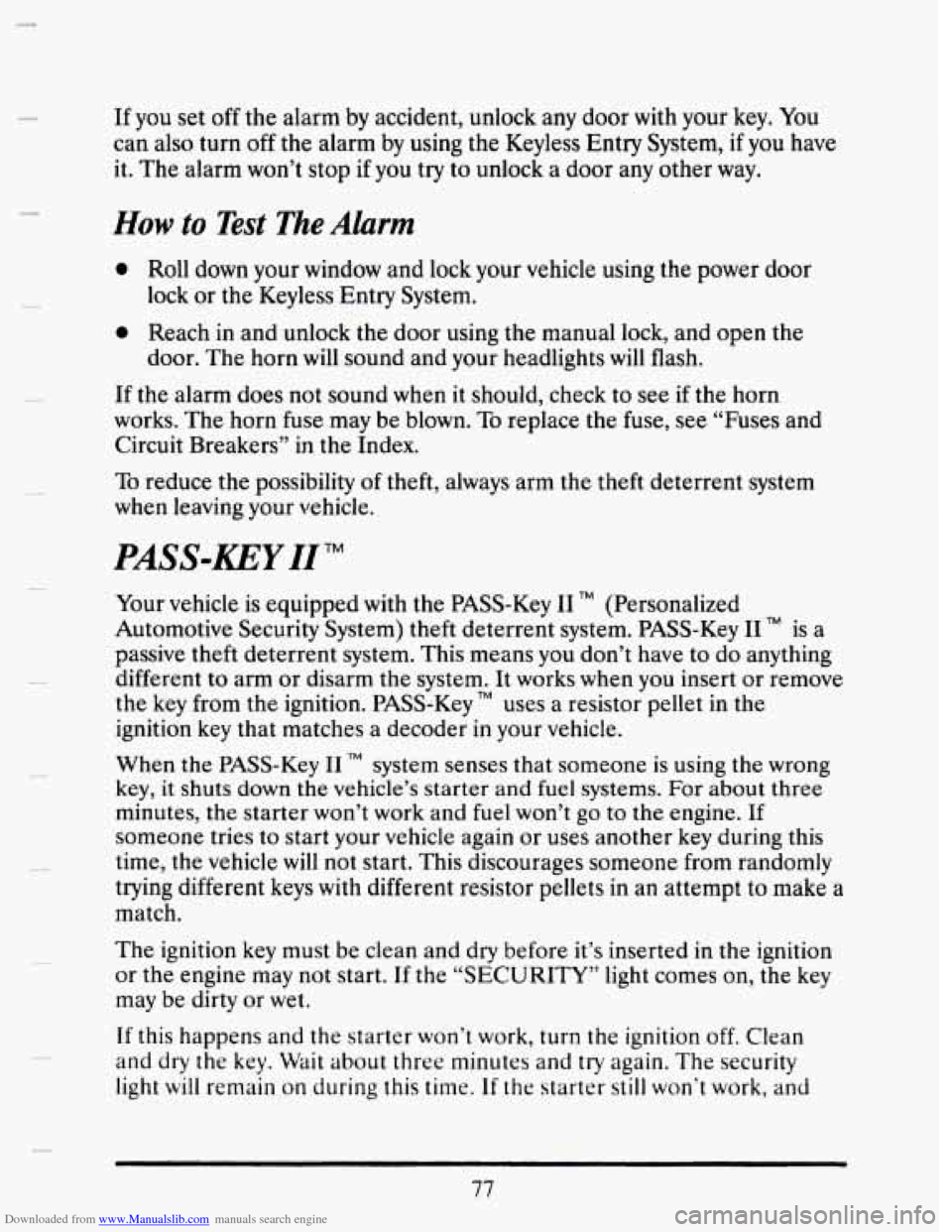
Downloaded from www.Manualslib.com manuals search engine If you set off the alarm by accident, unlock any door with your key. You
can also turn
off the alarm by using the Keyless Entry System, if you have
it. The alarm won’t stop
if you try to unlock a door any other way.
How to Test The Alarm
e Roll down your window and lock your vehicle using the power door
lock or the Keyless Entry System.
e Reach in and unlock the door using the manual lock, and open the
If the alarm does not sound when it should, check to see if the horn
works. The horn fuse may be blown.
To replace the fuse, see “Fuses and
Circuit Breakers” in the Index.
door. The horn
will sound and
your headlights will flash.
To reduce the possibility of theft, always arm the theft deterrent system
when leaving your vehicle.
PASS-KEY 11 TM
Your vehicle is equipped with the PASS-Key I1 TM (Personalized
Automotive Security System) theft deterrent system. PASS-Key I1
TM is a
passive theft deterrent system. This means you don’t have to do anything
different to arm or disarm the system. It works when you insert or remove
the key from the ignition. PASS-Key
’“ uses a resistor pellet in the
ignition key that matches a decoder
in your vehicle.
When the PASS-Key
I1 TM system senses that someone is using the wrong
key,
it shuts down the vehicle’s starter and fuel systems. For about three
minutes, the starter won’t work and fuel
won’t go to the engine. If
someone tries
to start your vehicle again or uses another key during this
time, the vehicle
will not start. This discourages someone from randomly
trying different keys with different resistor pellets in an attempt
to make a
match.
The ignition
key must be clean and dry before it’s inserted in the ignition
or the engine may not start. If the “SECURITY” light comes
on, the key
may be dirty or wet.
If this happens and the starter won’t work, turn the ignition off. Clean
and
dry the key. Wait about three minutes and try again. The security
light
will remain on during this time. If the starter still won’t work, and
Page 115 of 407
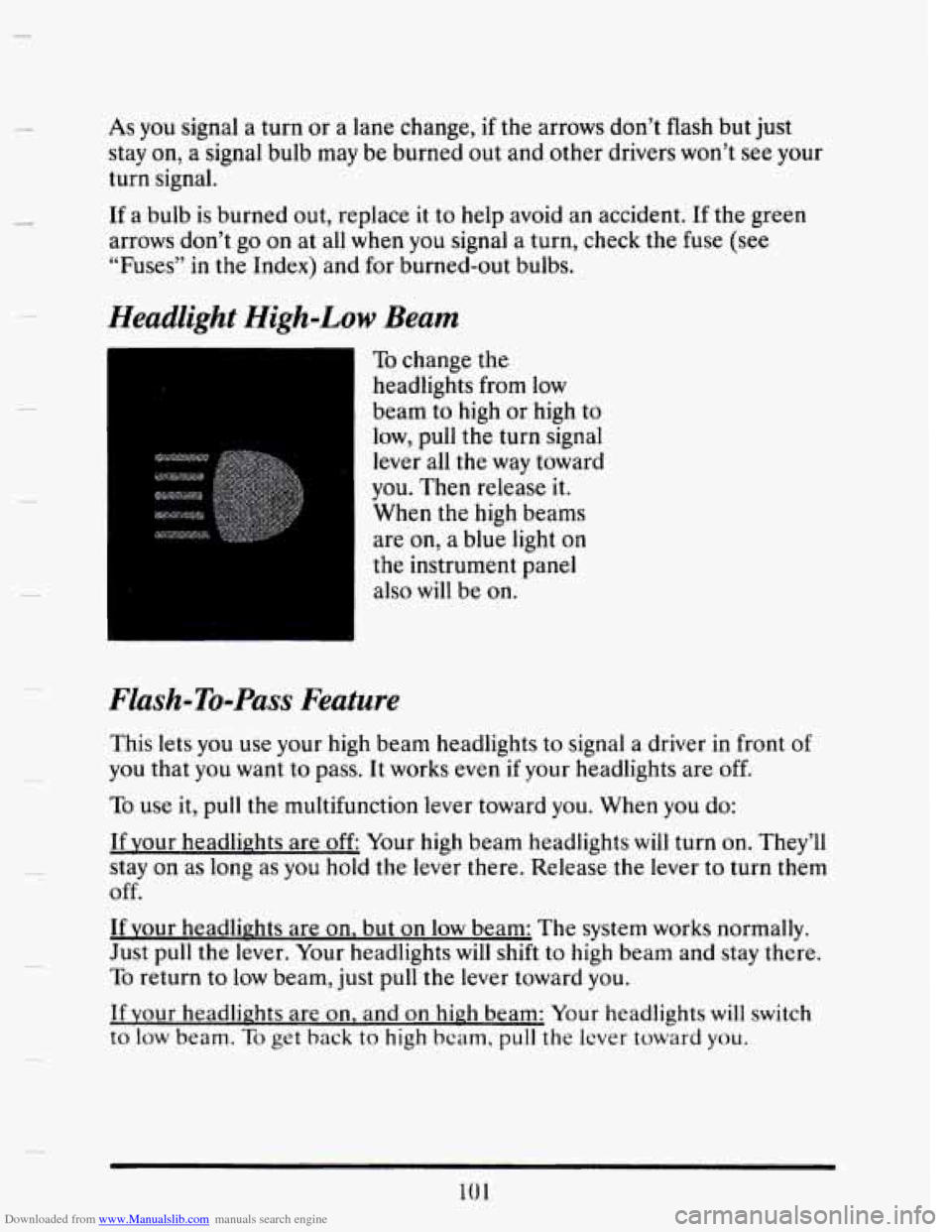
Downloaded from www.Manualslib.com manuals search engine c
As you signal a turn or a lane change, if the arrows don’t flash but just
stay
on, a signal bulb may be burned out and other drivers won’t see your
turn signal.
If a bulb is burned out, replace it to help avoid an accident. If the green
arrows don’t go on at all when you signal
a turn, check the fuse (see
“Fuses” in the Index) and for burned-out bulbs.
Headlight High-Low Beam
To change the
headlights from low
i beam to high or high to
low, pull the turn signal
lever all the way toward
you. Then release it.
When the high beams
are
on, a blue light on
the instrument panel
also will be on.
Flash-To-Pass Feature
This lets you use your high beam headlights to signal a driver in front of
you that you want to pass. It works even if your headlights are off.
To use it, pull the multifunction lever toward you. When you do:
If vour headlights are off Your high beam headlights will turn on. They’ll
stay on as long as you hold the
lever there. Release the lever to turn them
off.
If vour headlights are on, but on low beam: The system works normally.
Just pull the lever. Your headlights will shift to high beam and stay there.
To return to low beam, just pull the lever toward you.
If your headlights are on, and on high beam: Your headlights will switch
to low beam. To get back to high beam, pull the lever toward you.
10 1
Page 118 of 407
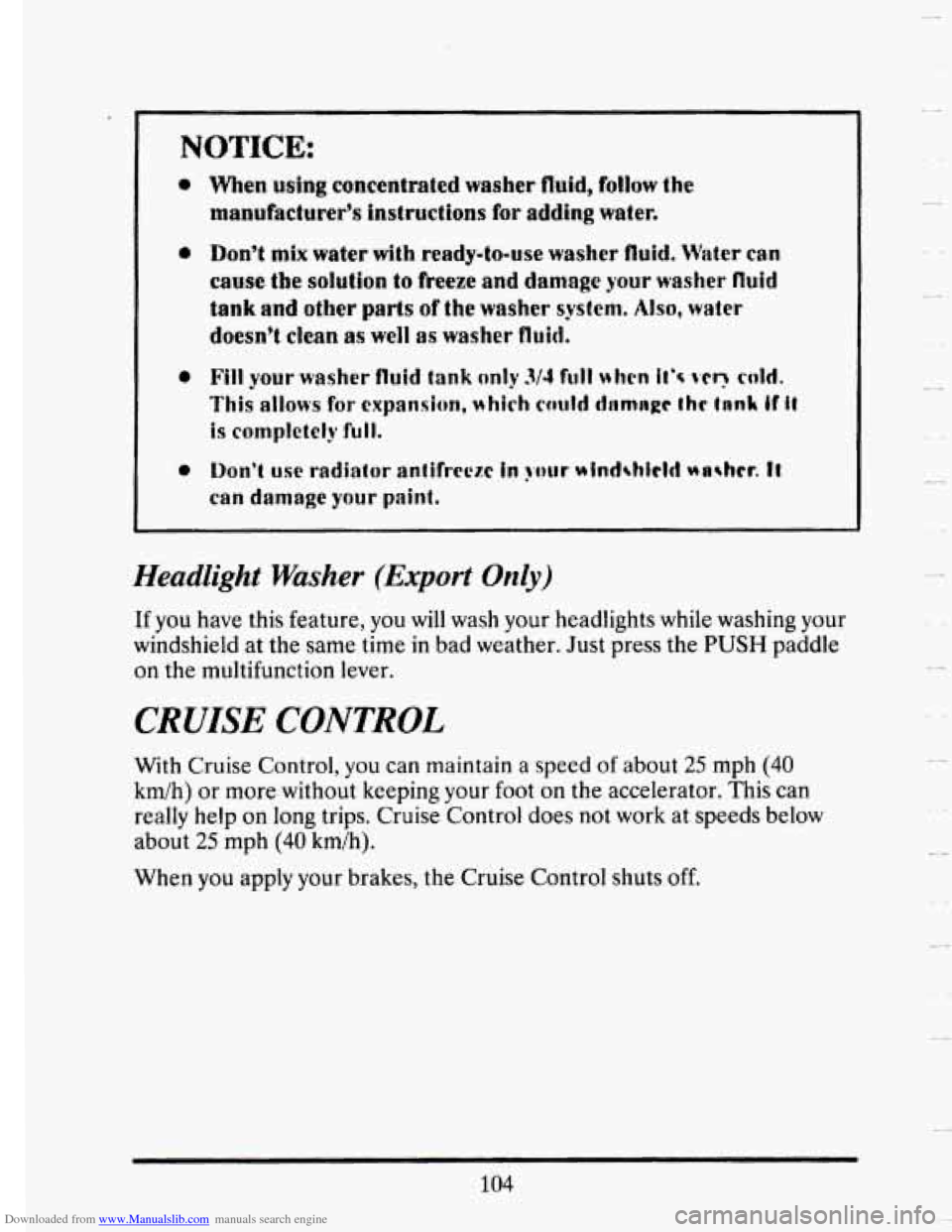
Downloaded from www.Manualslib.com manuals search engine NOTICE:
*
0
e
Men using concentrated washer fluid, follow the
manufacturer’s fnstcuctions for adding water.
Don’t mix water with readyto-use washer fluid, Water can
cause the solution to freeze and damage your washer fluid
tank and other parts of the washer system. Also, water
doesn’t clean as well as washer fluid.
Fill your washer fluid tank only 3/4 full $5 hen it’s vt~ cold.
This allows for expansion, which could dnmngc thc tank if it
is completely full.
Don’t use radiator antifrcezc in your uind4Md wathcr. It
can damage your paint.
Headlight Washer (Export Only)
If you have this feature, you will wash your headlights while washing your
windshield at the same
time in bad weather. Just press the PUSH paddle
on the multifunction lever.
CRUISE CONTROL
With Cruise Control, you can maintain a speed of about 25 mph (40
km/h) or more without keeping your foot on the accelerator. This can
really help on long trips. Cruise Control does not work
at speeds below
about
25 mph (40 km/h).
t-r
When you apply your brakes, the Cruise Control shuts off.
104
Page 124 of 407
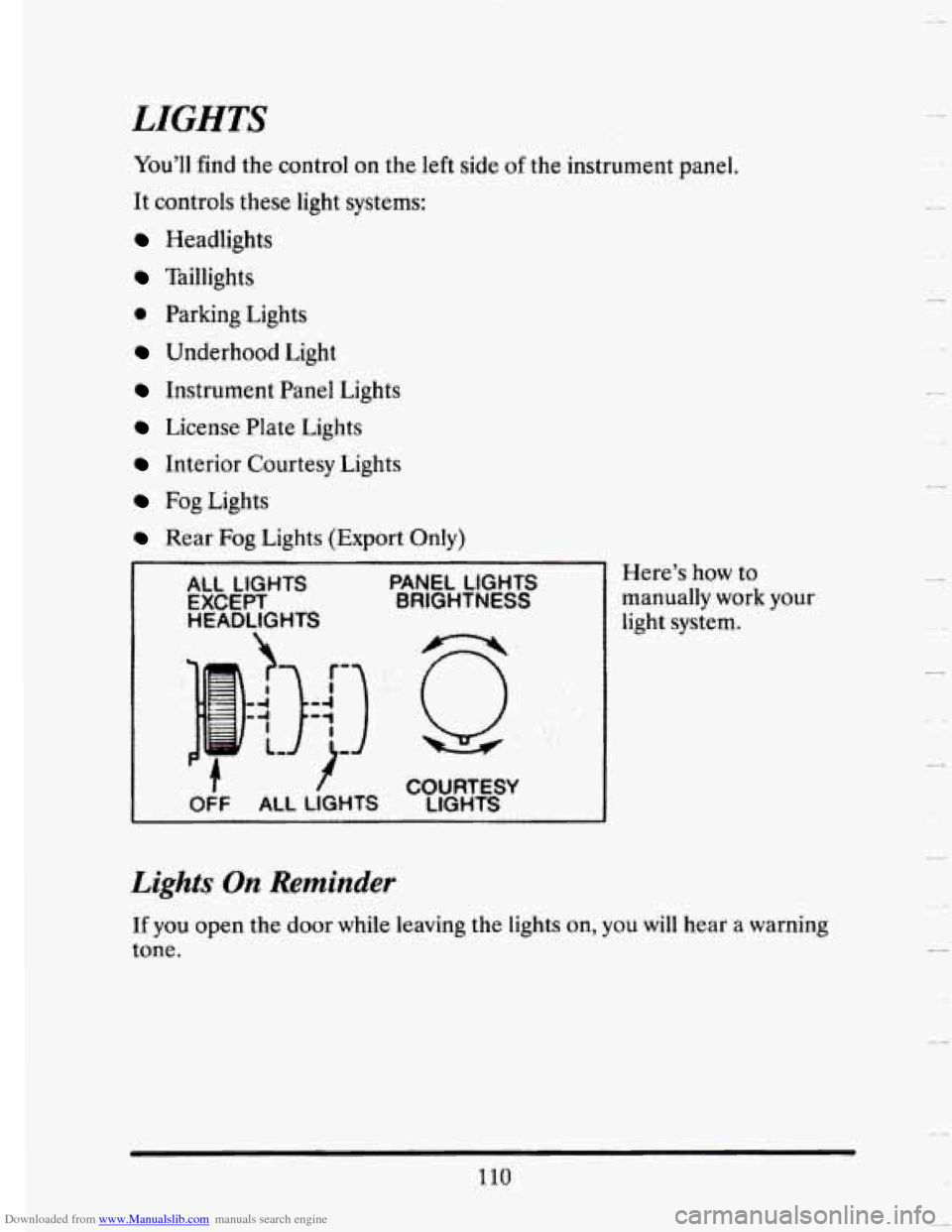
Downloaded from www.Manualslib.com manuals search engine LIGHTS
You’ll find the control on the left side of the instrument panel.
It controls these light systems:
Headlights
Taillights
0 Parking Lights
Underhood Light
Instrument Panel Lights
License Plate Lights
Interior Courtesy Lights
Fog Lights
Rear Fog Lights (Export Only)
ALL LIGHTS PANEL LIGHTS
EXCEPT BRIGHTNESS
HEADLIGHTS
COURTESY
LIGHTS
Here’s how to
manually work
your
light system.
Lights On Reminder
If you open the door while leaving the lights on, you will hear a warning
tone.
110
Page 127 of 407
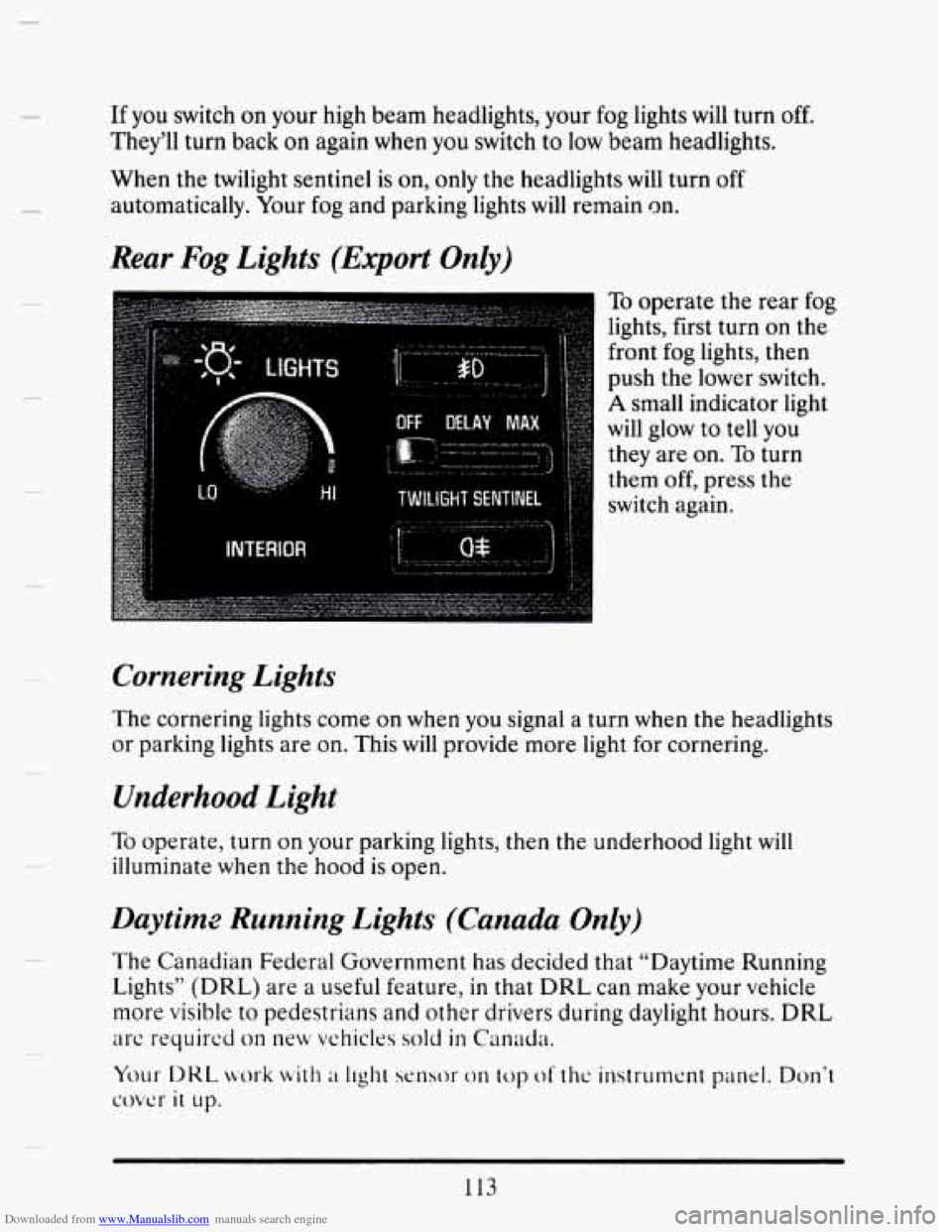
Downloaded from www.Manualslib.com manuals search engine If you switch on your high beam headlights, your fog lights will turn off.
They’ll turn back on again when you switch to low beam headlights.
When the twilight sentinel
is on, only the headlights will turn off
automatically. Your fog and parking lights will remain on.
Rear Fog Lights (Export Only)
To operate the rear fog
lights, first turn on the
front fog lights, then
push the lower switch.
A small indicator light
will glow to tell you
they are on.
To turn
them off, press the
switch again.
Cornering Lights
The cornering lights come on when you signal a turn when the headlights
or parking lights are
on. This will provide more light for cornering.
Underhood Light
To operate, turn on your parking lights, then the underhood light will
illuminate when the hood
is open.
Daytims Running Lights (Canada Only)
The Canadian Federal Government has decided that “Daytime Running
Lights” (DRL) are a useful feature,
in that DRL can make your vehicle
more visible to pedestrians and other drivers during daylight hours.
DRL
arc required on new vehicles sold in Canada.
Your DKL nw-k with ;I Ilght sensor on top of thc instrument panel. Don’t
covcr it up.
113
Page 128 of 407
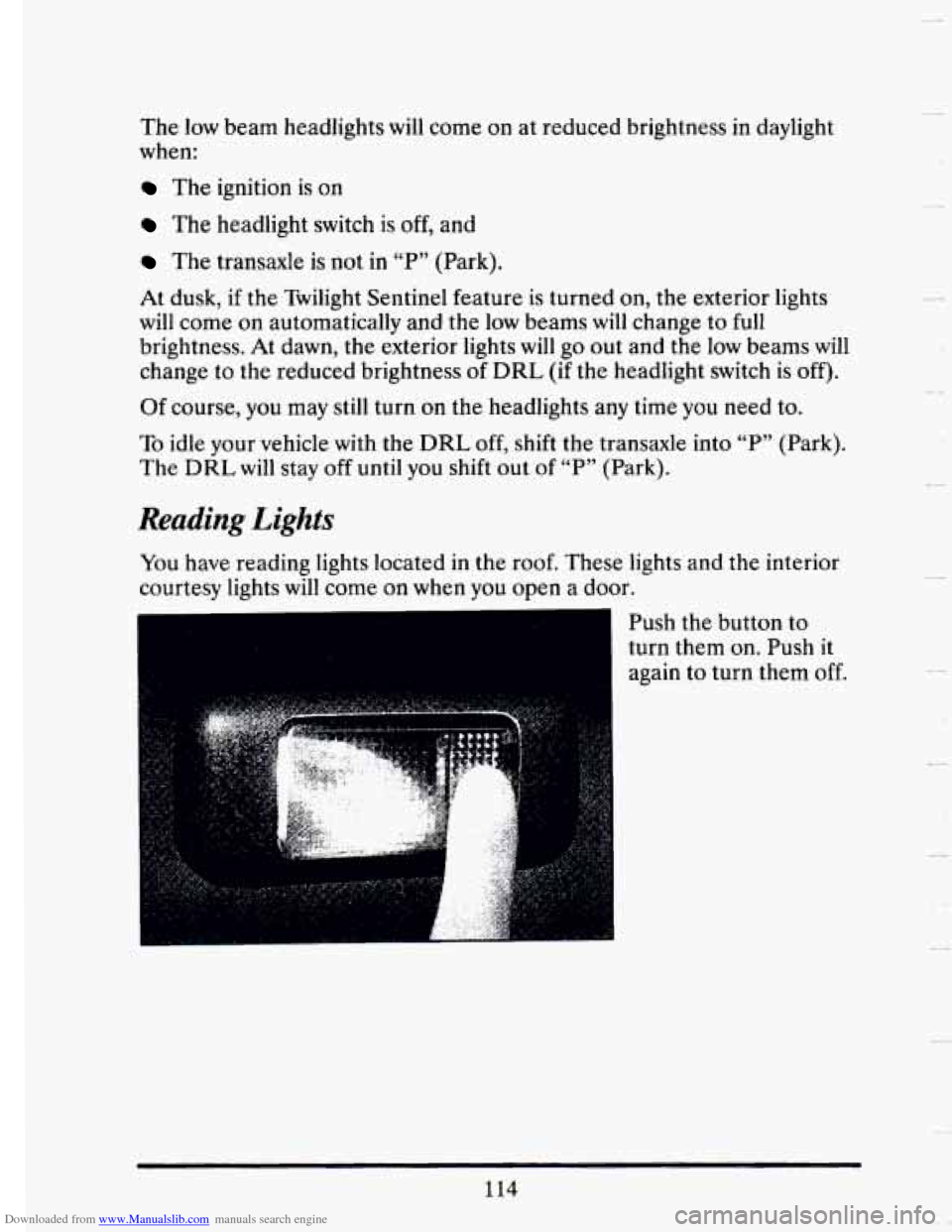
Downloaded from www.Manualslib.com manuals search engine The low beam headlights will come on at reduced brightness in daylight
when:
The ignition is on
The headlight switch is off, and
The transaxle is not in “P” (Park).
At dusk,
if the Twilight Sentinel feature is turned on, the exterior lights
will come on automatically and the low beams will change to full
brightness. At dawn, the exterior lights will
go out and the low beams will
change to the reduced brightness
of DRL (if the headlight switch is off).
Of course, you may still turn on the headlights any time you need to.
To idle your vehicle with the DRL off, shift the transaxle into “P” (Park).
The
DRL will stay off until you shift out of “P” (Park).
Reading Lights
You have reading lights located in the roof. These lights and the interior
courtesy lights will come
on when you open a door.
Push the button to turn them on. Push it
again to turn them
off.
114
Page 130 of 407
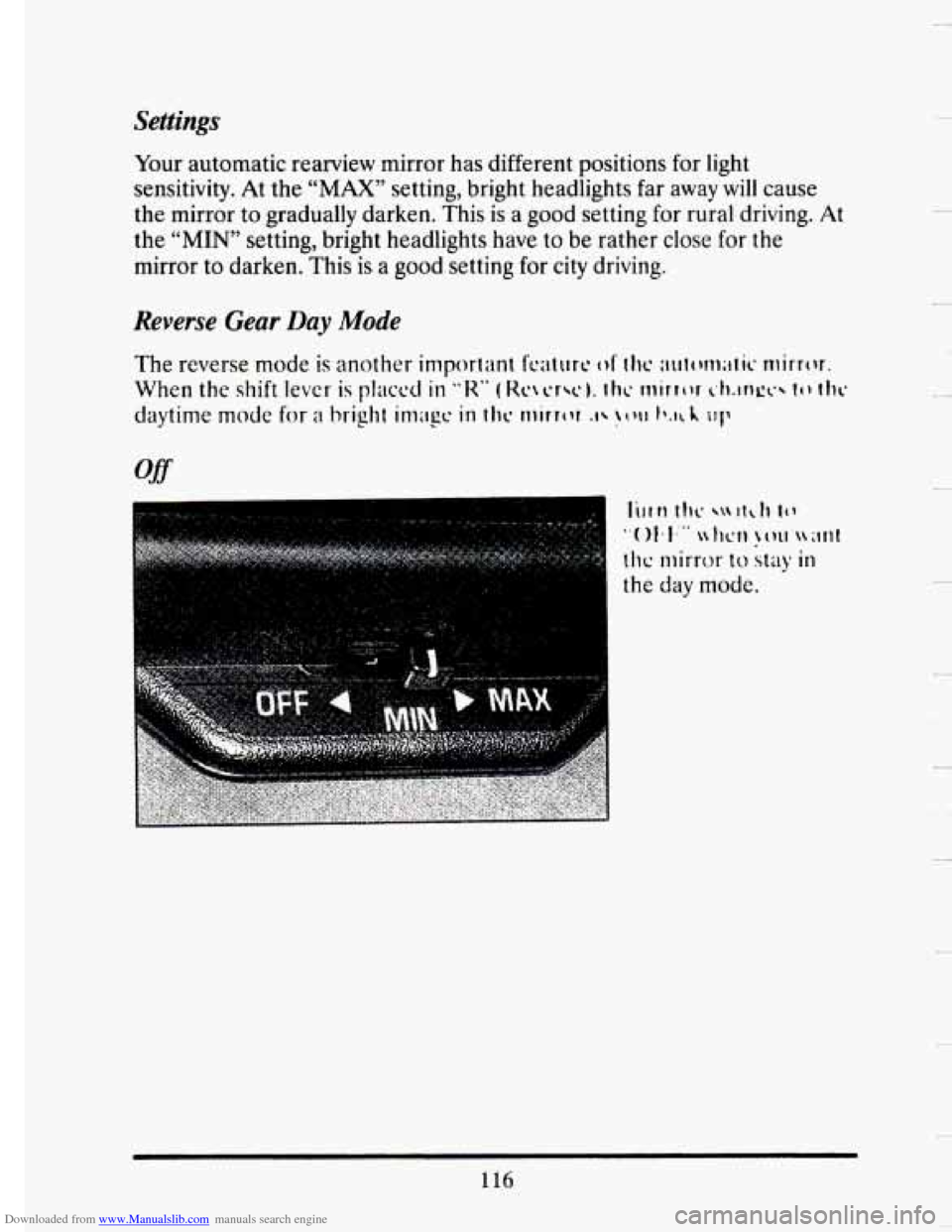
Downloaded from www.Manualslib.com manuals search engine Settings
Your automatic rearview mirror has different positions for light
sensitivity. At the
"MAX" setting, bright headlights far away will cause
the mirror to gradually darken. This is a good setting for rural driving. At
the
"MIN' setting, bright headlights have to be rather close for the
mirror to darken. This is a good setting for city driving.
Reverse Gear Day Mode
off
116
Page 205 of 407
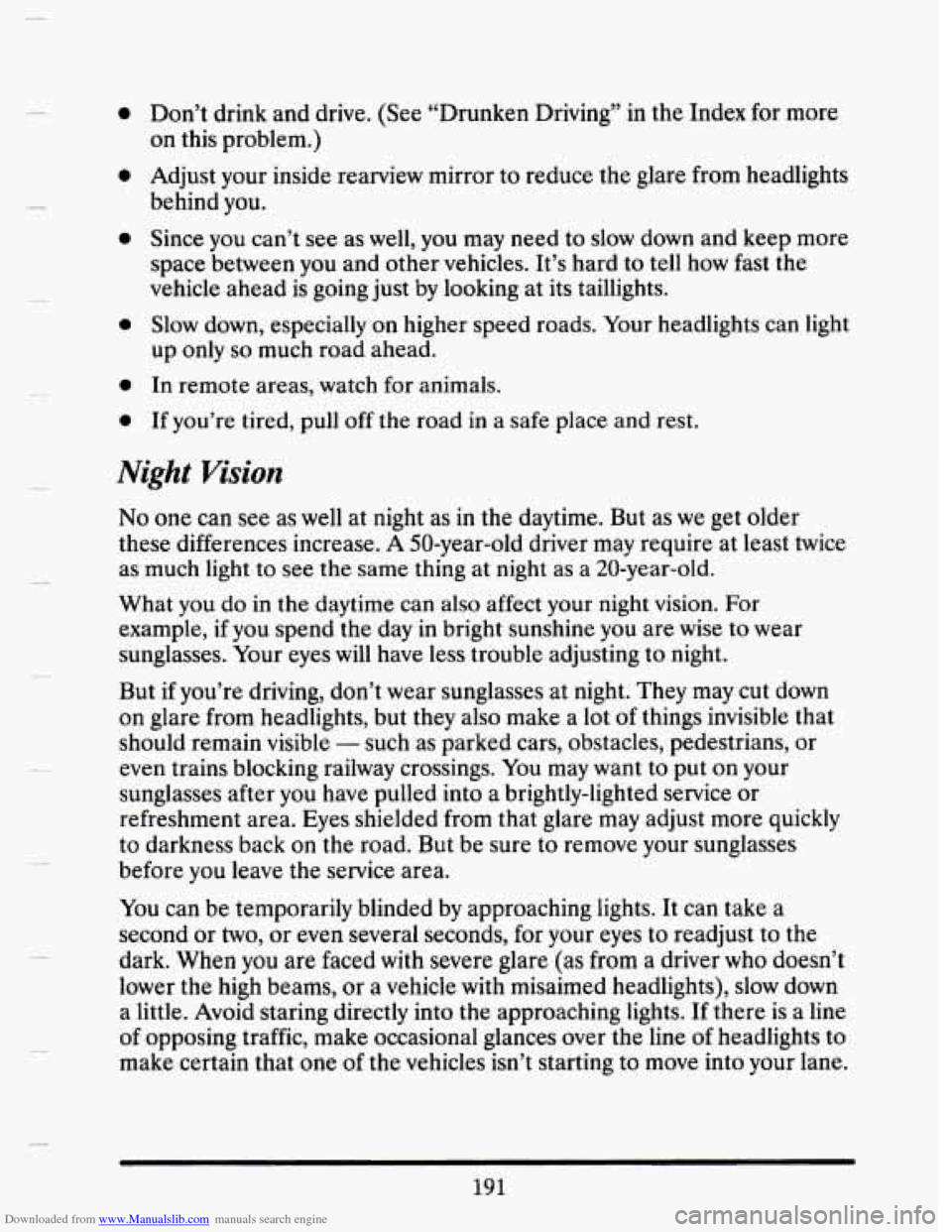
Downloaded from www.Manualslib.com manuals search engine 0
0 0
0
0
Don’t drink and drive. (See “Drunken Driving” in the Index for more
on this problem.)
Adjust your inside rearview mirror to reduce the glare from headlights
behind
you.
Since you can’t see as well, you may need to slow down and keep more
space between you and other vehicles. It’s hard to tell how fast the
vehicle ahead is going just by looking at its taillights.
Slow down, especially on higher speed roads. Your headlights can light
up only
so much road ahead.
In remote areas, watch for animals.
If you’re tired, pull off the road in a safe place and rest.
Night Vision
No one can see as well at night as in the daytime. But as we get older
these differences increase. A 50-year-old driver may require at least twice
as much light to see the same thing at night as a 20-year-old.
What you
do in the daytime can also affect your night vision. For
example, if you spend the day in bright sunshine you are wise to wear
sunglasses. Your eyes
will have less trouble adjusting to night.
But
if you’re driving, don’t wear sunglasses at night. They may cut down
on glare from headlights, but they also make a lot
of things invisible that
should remain visible
- such as parked cars, obstacles, pedestrians, or
even trains blocking railway crossings. You may want to put on your
sunglasses after you have pulled into a brightly-lighted service or
refreshment area. Eyes shielded from that glare may adjust more quickly
to darkness back
on the road. But be sure to remove your sunglasses
before you leave the service area.
You can be temporarily blinded by approaching lights. It can take a
second
or two, or even several seconds, for your eyes to readjust to the
dark. When
you are faced with severe glare (as from a driver who doesn’t
lower the high beams, or a vehicle with misaimed headlights), slow down
a little. Avoid staring directly into the approaching lights. If there is a line
of opposing traffic, make occasional glances over the line
of headlights to
make certain that
one of the vehicles isn’t starting to move into your lane.
191